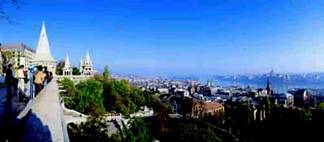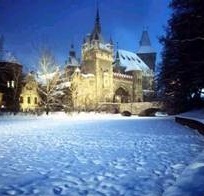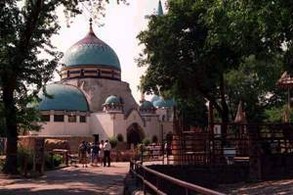Budapest - GoWithKids.com
Main menu
Budapest
BUDAPEST ..... Pearl of the Danube
 Hungary's capital is a great place for families. Budapest is divided into two parts by the river, the hilly side of Buda on the western side and the flat plain of Pest on the eastern side. These two parts of the city were once separate towns and were merged together with Ancient Buda (Óbuda) only in 1873. But its the beauty of Budapest is that really makes it stand apart -
Hungary's capital is a great place for families. Budapest is divided into two parts by the river, the hilly side of Buda on the western side and the flat plain of Pest on the eastern side. These two parts of the city were once separate towns and were merged together with Ancient Buda (Óbuda) only in 1873. But its the beauty of Budapest is that really makes it stand apart -
The kids will love exploring the walled Castle District and Old Town which contains some of Budapest’s most important monuments and museums, whilst parents will appreciate the sheer ambience. It consists of two distinct parts: the Old Town, where commoners lived during medieval times; and the Royal Palace, the original site of a castle built in the 13th century. The Old Town is filled with attractively painted streets, decorative churches and the famous Fishermen's Bastion, completed in 1905 on the site of a former fish market and named after the guild of fishermen responsible for defending this stretch of wall in the Middle Ages. It has commanding views over the city and the kids will love climbing the seven castellated bastions (representing the seven Magyar tribes who entered the Carpathian Basin in the 9th century). The most exiting way of getting to the Castle District is by taking the Funicular, a little cable car that takes you up the Castle Hill.
Immediately south of the Old Town is the Royal Palace which has been razed, rebuilt and redesigned over the past seven centuries. The palace houses a number of museums, including the National Gallery, which has an enormous collection devoted exclusively to Hungarian art. In a city that manages to surprise and enthrall in equal measure, reminders of Budapest's rich and often tragic history are ever present. Renovation of many fine buildings and the opening of new luxury hotels continue apace, while the scars of the nation's crushed 1956 uprising are still evident from the bullet hole ridden buildings yet to receive attention. My advice for family visitors would be to head along the magnificent Grand Boulevard to Heroes’ Square and Millennium Monument, with City Park right behind. Heroes’ Square was built in 1896, to celebrate the millennial anniversary of the Magyar conquest. Here the Archangel Gabriel at the top of a 36m (118ft) column is half-
My advice for family visitors would be to head along the magnificent Grand Boulevard to Heroes’ Square and Millennium Monument, with City Park right behind. Heroes’ Square was built in 1896, to celebrate the millennial anniversary of the Magyar conquest. Here the Archangel Gabriel at the top of a 36m (118ft) column is half-
Main Attractions
CITY PARK Budapest’s largest park, was designed by the French landscape-
GRAND CIRCUS BUDAPEST CITY PARK This world famous circus has performances at 3pm on Wednesdays, Thursdays and Fridays, 10.30am – 3pm – 7pm on Saturdays and 10.30am – 3pm on Sundays
.
BUDAPEST ZOO CITY PARK Website: www.zoobudapest.com Transport: Metro Széchenyi fürdo; trolley bus 72, 75 or 79; bus 4, 20 or 30. Opening hours: Daily 0900-
FUNFAIR CITY PARK This traditional funfair doesn’t compare with the modern ‘white-
FUNICULAR Opened in 1870, authentic-
PALACE OF WONDERS Central Europe's first interactive, scientific playhouse with more than 100 spectacular, hands-
SIGHTSEEING BALLOON This helium-
TROPICARIUM OCEANARIUM The largest marine aquarium in Middle-
CHILDREN’S RAILWAY This fascinating service is operated by 10-
THE NOSTALGIC RAILWAY PARK & MUSEUM The whole family will enjoy visiting here. Apart from the many steam engines and carriages on show , there’s hand cars and self-
CHAIR LIFT This amazing ski lift lookalike with chairs hanging from a haulage cable has an elevation between the two terminals of 262m. The journey takes around 15 minutes and you will get some amazing views on the way.In service: 9.00-
BUDA CASTLE LABYRINTH -
PAL-
CASTLE CAVE Another section of the cave system under the Buda Hill has been recently been opened to the public. The cave consists of cavity turned cellars and man-
MARGARET ISLAND Wedged in a loop of the River Danube and linked by a bridge at each end to Buda and Pest, the two-
CHAIN BRIDGE Eight bridges link Buda to Pest but the Chain Bridge is the first and most famous, with its solid arches and lion statues. Count István Széchenyi commissioned the Englishman responsible for London’s Hammersmith Bridge, William Tierney Clark, to design a bridge, and the Scotsman, Adam Clark, to oversee construction. Completed in 1848, the bridge was inaugurated in 1849, allowing for the integration of Buda, Pest and Óbuda in 1872. The Nazis having done considerable damage, the bridge was repaired and re-
BUDA ROYAL PALACE MUSEUM First inhabited by King Béla IV, after the 1241 Mongol invasion, the Royal Palace had its heyday during King Mátyás’s reign (1458-
LUDWIG MUSEUM Website: www.c3.hu/~ludwig Opening hours: Tues-
HUNGARIAN NATIONAL GALLERY Website: www.mng.hu Opening hours: Tues-
HOTEL GELLERT AND THERMAL BATHS Prudes are not advised to try out the Gellért Baths – valued since the Turkish occupation for their medicinal qualities – or any other thermal spas in the city, for that matter. Upon entrance, a strip of cloth is given to men and a tiny apron to women. Massages last 15 or 40 minutes – a vigorous experience not to be embarked upon by the faint-
BUDAPEST PARLIAMENT Imre Steindl’s design for Budapest’s Parliament, inspired by London’s Houses of Parliament, won first prize in a competition to celebrate the 1000th year of the Hungarian nation. The edifice, with its elegant neo-
TRANSPORT MUSEUM Railway locomotive models unique in Europe (made on a scale of 1:5), old cars, motorcycles, trams, and models of ships show the development of transportation in Hungary. Tue-
AVIATION MUSEUM Original passenger planes and gliders are displayed along with models and the space capsule of the first Hungarian cosmonaut. 10.00-
SZECHNYI BATHS & SWIMMING POOL It is one of Europe`s largest bath complexes. The atmosphere of Roman bathing culture may be felt in its light, spacious pool halls, while Greek bathing culture is reflected in the tub baths, but traces of Nordic traditions may also be found in the heat chambers, saunas and dipping pools. This first spa of Pest owes its existence to the well dug by Vilmos Zsigmondy in 1879. The present bath building was constructed in 1913. The swimming pool was built in 1927, but it was only open from May till September until the 1960ies, when, in 1963, it was made suitable for winter swimming as well. Since then it has been open throughout the year. The two `public bath` units were established also in 1927, today housing the mixed baths and the complex physiotherapy units (day hospital)
.
HUNGARIAN NATURAL HISTORY MUSEUM The interactive permanent exhibition and the interesting temporary exhibitions present an inside view of the colourful world of minerals, primordial beings, plants, animals and people. Open: 10.00-
STATUE PARK Until the recent political changes in Hungary, the gigantic monuments collected in this park used to ornament the parks and squares of Budapest. Just as Lenin Boulevard and Marx Square no longer exist in Budapest, so their statues and monuments have been sent into exile to the Statue Park.www.szoborpark.hu Opening hours: Daily 1000-
LAZAR EQUESTRIAN PARK Although located some 35km from Budapest, Lazar Equestrian Park is well worth visiting. The park was established by the horse-
HEREND PORCELANIUM Herend Porcelain is famous throughout the world and the modern visitor complex gives visitors the opportunity to see just how this unique, expensive porcelain is made and crafted. The museum is a treasure-
GODOLLO ROYAL PALACE The magnificent Royal Palace of Godollo is the largest baroque palace in Hungary. It has been open to the public since 1996 and there’s a continuous program of renovation as more and more parts of this impressive building are being restored. The Palace is surrounded by 28 hectares of parkland and there’s a café and gift shop on the ground floor.Open: 10am-
LAKE BALATON This oblong lake, about 100km from Budapest, is one of the largest in Europe, covering an area of almost 600 sq km. Often called 'the nation's playground,' Balaton is divided into two quite different shores: the south, which is essentially one long resort of high-
Dominating the south is Siófok, the largest of Balaton's resorts. The dedicated pursuits here are eating, drinking, swimming and sunbathing -
The north's oldest and most popular resort is Balantonfüred. During the 19th century it was the gathering place for politicians and cultural leaders, then a writers' colony and, by 1900, a summer retreat for the country's emerging middle class. It remains a sophisticated, yet peaceful place, and counts among its attractions a splendid promenade, a number of artist's museums and warm-
BALATON BOB This bobsleigh on rails will really thrill the kids, large or small! A pulley system will tow you to the top of a hill before releasing the Bob for you to travel down at whatever speed you wish. There is a braking system to control your speed so younger children can sit on your lap, the older ones will want to take the faster route of course!www.balaton.hu/bob
The Budapest Card is simple to use and excellent value. The card provides free travel on public transport, entrance to 60 museums and attractions – such as the Hungarian National Gallery, Budapest Zoo and the Museum of Fine Art – half-
The Hungarian language belongs to the Finno-
TOURIST INFORMATION Tourinform Budapest Website: www.hungarytourism.hu Opening hours: Daily 0800-
MALEV – HUNGARIAN AIRLINES www.malev.huUK tel: 020 7439 0577 begin_of_the_skype_highlighting7439 0577end_of_the_skype_highlighting
Park Hotel Flamenco
Flamenco is a comfortable and very pleasant four star hotel situated in a leafy suburb of Buda. Rooms are spacious and elegantly furnished with views overlooking the nearby park -
Check out the Danubius website for a full list of their Hotels and Spas.
www.danubiusgroup.com/
Fortuna RestaurantFortuna House is situated in the heart of the Castle. It was built in the 14th century and there is an exclusive restaurant on the first floor with the atmosphere of medieval ages. There is also a Taverna Restaurant with a spirit of the renaissance surrounded by archaic walls of the cellar.www.kulturinfo.hu/moreinfo.gcw
Karpatia RestaurantThe restaurant was built at the beginning of the last century on the ground floor of a residential building going back to the 19th century and located in the heart of historic downtown Budapest close to the Pest side of Elizabeth Bridge. Its internal design reflects Hungarian early Renaissance.www.karpatia.hu
Gundel RestaurantThe Gundel is a ‘must visit’ restaurant and the place where the rich and famous from throughout the world visit when in Budapest. The menu is based on traditional Hungarian cuisine as once practiced by Károly Gundel and his staff. They prepare refined versions of Hungarian dishes, revive traditional fares once eaten at the tables of East European aristocracy and offer specialties of the worlds major culinary cultures. www.gundel.huout the following web site for further details of these restaurants and much more useful information about Budapest and Hungary.
www.kulturinfo.hu